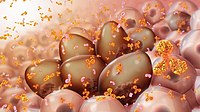
Inhibition of CXCL12/CXCR4 axis as a potential targeted therapy of advanced gastric carcinoma
Sign Up to like & getrecommendations! Published in 2017 at "Cancer Medicine"
DOI: 10.1002/cam4.1085
Abstract: The whole outcome for patients with gastric carcinoma (GC) is very poor because most of them remain metastatic disease during survival even at diagnosis or after surgery. Despite many improvements in multiple strategies of chemotherapy,… read more here.
Keywords: cxcr4 axis; targeted therapy; cxcl12 cxcr4; cxcl12 ... See more keywords

Activated hepatic stellate cells regulate MDSC migration through the SDF-1/CXCR4 axis in an orthotopic mouse model of hepatocellular carcinoma
Sign Up to like & getrecommendations! Published in 2019 at "Cancer Immunology, Immunotherapy"
DOI: 10.1007/s00262-019-02414-9
Abstract: Hepatic stellate cells (HSCs) are important stromal cells and pivotal mediators involved in the pathogenesis and immunosuppression of hepatocellular carcinoma (HCC). The liver has been demonstrated to be a site for accumulation of tumor-induced myeloid-derived… read more here.
Keywords: sdf cxcr4; hcc; cxcr4 axis; mdsc migration ... See more keywords

SDF-1/CXCR4 axis coordinates crosstalk between subchondral bone and articular cartilage in osteoarthritis pathogenesis.
Sign Up to like & getrecommendations! Published in 2019 at "Bone"
DOI: 10.1016/j.bone.2019.05.010
Abstract: Crosstalk between subchondral bone and articular cartilage is considered a central feature of osteoarthritis (OA) initiation and progression, but its underlying molecular mechanism remains elusive. Meanwhile, specific administration of drugs in subchondral bone is also… read more here.
Keywords: cxcr4 axis; bone; articular cartilage; subchondral bone ... See more keywords

CXCL12/CXCR4 axis in the microenvironment of solid tumors: A critical mediator of metastasis.
Sign Up to like & getrecommendations! Published in 2020 at "Life sciences"
DOI: 10.1016/j.lfs.2020.117534
Abstract: Tumors are dynamic tissue masses, so requiring continuous exposure to the host cells, nurturing them into pave a path for tumor growth and metastasis. C-X-C chemokine ligand 12 (CXCL12)/C-X-C chemokine receptor type 4 (CXCR4) is… read more here.
Keywords: microenvironment; cxcr4 axis; metastasis; cxcl12 cxcr4 ... See more keywords

CXCL12/CXCR4 axis supports mitochondrial trafficking in tumor myeloma microenvironment
Sign Up to like & getrecommendations! Published in 2022 at "Oncogenesis"
DOI: 10.1038/s41389-022-00380-z
Abstract: Mesenchymal stromal cells (MSCs) within the protective microenvironment of multiple myeloma (MM) promote tumor growth, confer chemoresistance and support metabolic needs of plasma cells (PCs) even transferring mitochondria. In this scenario, heterocellular communication and dysregulation… read more here.
Keywords: mscs; myeloma; microenvironment; cxcr4 axis ... See more keywords

Angiogenic Capacity of Dental Pulp Stem Cell Regulated by SDF-1α-CXCR4 Axis
Sign Up to like & getrecommendations! Published in 2017 at "Stem Cells International"
DOI: 10.1155/2017/8085462
Abstract: Previously, the perivascular characteristics of dental pulp stem cells (DPSCs) were reported, which suggested the potential application of DPSCs as perivascular cell source. In this study, we investigated whether DPSCs had angiogenic capacity by coinjection… read more here.
Keywords: angiogenic capacity; cxcr4 axis; dpscs; stem ... See more keywords

Abstract 3672: Insulin-like growth factor 2 (IGF-2) mRNA binding protein 3-mediated regulation of CD164-CXCR4 axis impacts aggressiveness of Ewing sarcoma
Sign Up to like & getrecommendations! Published in 2019 at "Tumor Biology"
DOI: 10.1158/1538-7445.am2019-3672
Abstract: INTRODUCTION: The genomic stability of primary and metastatic Ewing sarcoma (EWS), the second most common primary bone tumor in pediatric age, evokes epigenetic or mRNA translational reprogramming as mechanisms involved in tumor progression. The oncofetal… read more here.
Keywords: growth; cxcr4; cd164; cd164 cxcr4 ... See more keywords

The SDF-1/CXCR4 axis promotes recovery after spinal cord injury by mediating bone marrow-derived from mesenchymal stem cells
Sign Up to like & getrecommendations! Published in 2017 at "Oncotarget"
DOI: 10.18632/oncotarget.14619
Abstract: This study aims to explore the role of the SDF-1/CXCR4 axis in mediating BMSCs and SCI recovery. BMSCs were collected and SCI rat models were established. Wistar rats were assigned into the blank control, sham,… read more here.
Keywords: sdf cxcr4; sci; cxcr4 axis; sci bmscs ... See more keywords

Role and Therapeutic Targeting of SDF-1α/CXCR4 Axis in Multiple Myeloma
Sign Up to like & getrecommendations! Published in 2021 at "Cancers"
DOI: 10.3390/cancers13081793
Abstract: Simple Summary The SDF-1α/CXCR4 axis plays crucial roles in proliferation, survival, invasion, dissemination, and drug resistance in multiple myeloma. This review summarizes the pleiotropic role of the SDF-1α/CXCR4 axis in multiple myeloma and introduces the… read more here.
Keywords: sdf cxcr4; cxcr4 axis; multiple myeloma; myeloma ... See more keywords

Engagement of the CXCL12–CXCR4 Axis in the Interaction of Endothelial Progenitor Cell and Smooth Muscle Cell to Promote Phenotype Control and Guard Vascular Homeostasis
Sign Up to like & getrecommendations! Published in 2022 at "International Journal of Molecular Sciences"
DOI: 10.3390/ijms23020867
Abstract: Endothelial progenitor cells (EPCs) are involved in vascular repair and modulate properties of smooth muscle cells (SMCs) relevant for their contribution to neointima formation following injury. Considering the relevant role of the CXCL12–CXCR4 axis in… read more here.
Keywords: interaction; cell; cxcl12 cxcr4; cxcr4 axis ... See more keywords